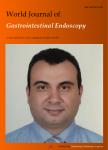Re-bleeding events in patients with obscure gastrointestinal bleeding after negative capsule endoscopy
Re-bleeding events in patients with obscure gastrointestinal bleeding after negative capsule endoscopy作者机构:Gastroen-terology DepartmentHospital Egas MonizCentro Hospitalar Lisboa Ocidental
出 版 物:《World Journal of Gastrointestinal Endoscopy》 (世界胃肠内镜杂志(英文版)(电子版))
年 卷 期:2015年第7卷第4期
页 面:403-410页
学科分类:1002[医学-临床医学] 100201[医学-内科学(含:心血管病、血液病、呼吸系病、消化系病、内分泌与代谢病、肾病、风湿病、传染病)] 10[医学]
主 题:Capsule endoscopy Gastrointestinalhemorrhage Anemia Angiodysplasia Risk factors
摘 要:AIM: To investigate long-term re-bleeding events after a negative capsule endoscopy in patients with obscure gastrointestinal bleeding(OGIB) and the risk factors associated with the ***: Patients referred to Hospital Egas Moniz(Lisboa, Portugal) between January 2006 and October 2012 with OGIB and a negative capsule endoscopy were retrospectively analyzed. The following study variables were included: demographic data, comorbidities, bleeding-related drug use, hemoglobin level, indication for capsule endoscopy, post procedure details, work-up and follow-up. Re-bleeding rates and associated factors were assessed using a Cox proportional hazard analysis. The Kaplan-Meier method was used to estimate the cumulative incidence of re-bleeding at 1, 3 and 5 years, and the differences between factors were ***: The study population consisted of 640 patients referred for OGIB investigation. Wireless capsule endoscopy was deemed negative in 113 patients(17.7%). A total of 64.6% of the population was female, and the median age was 69 years. The median follow-up was forty-eight months(interquartile range 24-60). Re-bleeding occurred in 27.4% of the cases. The median time to re-bleeding was fifteen months(interquartile range 2-33). In 22.6%(n = 7) of the population, small-bowel angiodysplasia was identified as the culprit lesion. A univariate analysis showed that age 65 years old, chronic kidney disease, aortic stenosis, anticoagulant use and overt OGIB were risk factors for re-bleeding; however, on a multivariate analysis, there were no risk factors for re-bleeding. The cumulative risk of re-bleeding at 1, 3 and 5 years of follow-up was 12.9%, 25.6% and 31.5%, *** who presented with overt OGIB tended to rebleed sooner(median time for re-bleeding: 8.5 mo vs 22 mo).CONCLUSION: Patients with OGIB despite a negative capsule endoscopy have a significant re-bleeding risk; therefore, these patients require an extended follow-up strategy.



